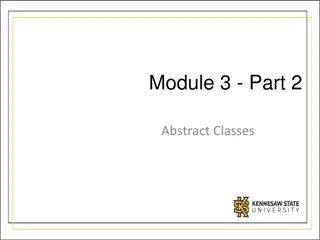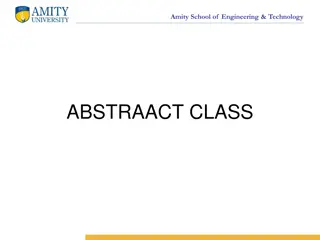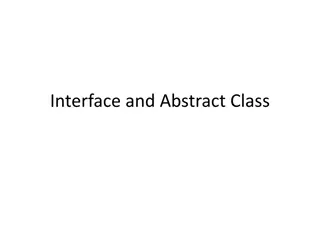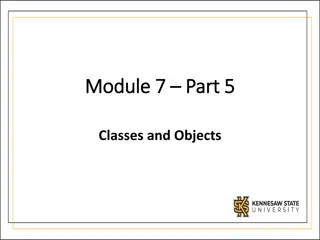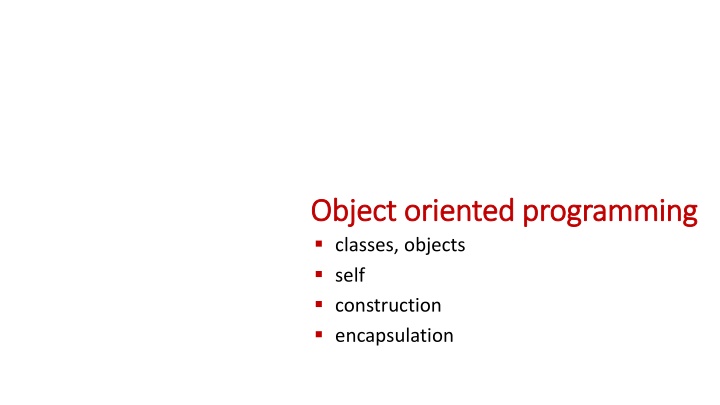
Understanding Object-Oriented Programming Paradigm and History
Object-oriented programming (OOP) is a programming paradigm that focuses on classes, objects, and encapsulation. It allows for the creation of abstract data types through user-defined types. OOP is supported by various programming languages, including Python. The history of OOP dates back to the mid-1960s with languages like Simula 67, Smalltalk, and Eiffel, leading to modern languages like Java, C++, and Python. Design patterns and popular books have further enriched the understanding of OOP concepts and implementation.
Download Presentation

Please find below an Image/Link to download the presentation.
The content on the website is provided AS IS for your information and personal use only. It may not be sold, licensed, or shared on other websites without obtaining consent from the author. If you encounter any issues during the download, it is possible that the publisher has removed the file from their server.
You are allowed to download the files provided on this website for personal or commercial use, subject to the condition that they are used lawfully. All files are the property of their respective owners.
The content on the website is provided AS IS for your information and personal use only. It may not be sold, licensed, or shared on other websites without obtaining consent from the author.
E N D
Presentation Transcript
Object Object oriented oriented programming classes, objects self construction encapsulation programming
Object Object Oriented Oriented Programming Programming Programming paradigm, other paradigms are e.g. functional programming where the focus is on functions, lambda s and higher order functions, and imperative programming focusing on sequences of statements changing the state of the program Core concepts are objects, methods and classes, allowing one to construct abstract data types, i.e. user defined types objects have states methods manipulate objects, defining the interface of the object to the rest of the program OO supported by many programming languages, including Python
Object Oriented Programming Object Oriented Programming - - History (selected programming languages) (selected programming languages) History Mid 1960 s Simula 67 (Ole-Johan Dahl and Kristen Nygaard, Norsk Regnesentral Oslo) Introduced classes, objects, virtual procedures Smalltalk (Alan Kay, Dan Ingalls, Adele Goldberg, Xerox PARC) Object-oriented programming, fully dynamic system (opposed to the static nature of Simula 67 ) Eiffel (Bertrand Meyer, Eiffel Software) Focus on software quality, capturing the full software cycle C++ (Bjarne Stroustrup [MSc Aarhus 1975], AT&T Bell Labs) Java (James Gosling, Sun) C# (Anders Hejlsberg (studied at DTU) et al., Microsoft) Python (Guido van Rossum) Multi-paradigm programming language, fully dynamic system 1970 s 1985 1985 1995 2000 1991 Byte Magazine, August 1981 Note: Java, C++, Python, C# are among Top 5 on TIOBE January 2023 index of popular languages (only non OO language among Top 5 was C)
Design Patterns (not part of Design Patterns (not part of this reoccuring reoccuring patterns in software design patterns in software design this course course) ) Java cookbook 2003 Java textbook 2004 Java textbook 2010 The Classic book 1994 (C++ cookbook) A very alternative book 2004 (Java, very visual) ...and many more books on the topic of Design Patterns, also with Python
Some Some known known classes classes, , objects objects, and , and methods methods Type / class Objects Methods (examples) Python shell > 5 + 7 # + calls .__add__(7) | 12 > (5).__add__(7) # eq. to 5 + 7 | 12 > (7).__eq__(7) # eq. to 7 == 7 | True > 'aBCd'.lower() | 'abcd' > 'abcde'.__len__() # .__len__() called by len(...) | 5 > ['x', 'y'].__mul__(2) | ['x', 'y', 'x', 'y'] > {'foo' : 42}.__getitem__('foo') # eq. to {'foo' : 42}['foo'] | 42 > None.__str__() # used by str(...) | 'None' > 'abc'.__str__(), 'abc'.__repr__() | ('abc', "'abc'") int 0 -7 42 1234567 .__add__(x), .__eq__(x), .__str__() str "" 'abc' '12_ a' .isdigit(), .lower(), .__len__() list [] [1,2,3] ['a', 'b', 'c'] .append(x), .clear(), .__mul__(x) dict {'foo' : 42, 'bar' : 5} .keys(), .get(), .__getitem__(x) NoneType None .__str__() Example: The function str(obj) calls the methods obj.__str__() or obj.__repr__(), if obj.__str__ does not exist. print calls str.
Classes and Objects Classes and Objects objects (instances) class (type) student_DD name = 'Donald Duck' id = '107' data attributes class Student set_name(name) set_id(student_id) student_MM name = 'Mickey Mouse' id = '243' class methods get_name() get_id() student_SM name = 'Scrooge McDuck' id = '777' creating instances of class Student using constructor Student() docs.python.org/3/tutorial/classes.html
Using the Using the Student class class student.py student_DD = Student() student_MM = Student() student_SM = Student() student_DD.set_name('Donald Duck') student_DD.set_id('107') student_MM.set_name('Mickey Mouse') student_MM.set_id('243') student_SM.set_name('Scrooge McDuck') student_SM.set_id('777') Python shell | Donald Duck has id 107 | Mickey Mouse has id 243 | Scrooge McDuck has id 777 Call constructor for class Student. Each call returns a new Student object. Call class methods to set data attributes students = [student_DD, student_MM, student_SM] for student in students: print(student.get_name(), 'has id', student.get_id()) Call class methods to read data attributes
class class Student name of class docstring containing documentation for class student.py class Student: '''Documentation of class''' class definitions start with the keyword class the first argument to all class methods is a reference to the object called upon, and by convention the first argument should be named self. def set_name(self, name): self.name = name often called mutator methods, since they change the state of use self. to access an attribute of an object or class method (attribute reference) def set_id(self, student_id): self.id = student_id an object def get_name(self): return self.name often called accessor methods, since they only read the state of def get_id(self): return self.id an object Note In other OO programming languages the explicit reference to self is not required (in Java and C++ self is the keyword this) class method definitions start with keyword def (like normal function definitions)
When are object attributes initialized ? When are object attributes initialized ? Python shell > x = Student() > x.set_name("Gladstone Gander") > x.get_name() | 'Gladstone Gander' > x.get_id() | AttributeError: 'Student' object has no attribute 'id' Default behaviour of a class is that instances are created with no attributes defined, but has access to the attributes / methods of the class In the previous class Student both the name and id attributes were first created when set by set_name and set_id, respectively
Class construction and Class construction and __init__ When an object is created using class_name()it s initializer metod __init__ is called. To initialize objects to contain default values, (re)define this function. student.py class Student: def __init__(self): self.name = None self.id = None ... previous method definitions ...
Question Question What What is is printed printed ? ? a) 1 b) 2 c) 3 d) 4 e) 5 f) Don t know Python shell > class C: def __init__(self): self.v = 0 def f(self): self.v = self.v + 1 return self.v > x = C() > print(x.f() + x.f())
__init__ with arguments with arguments When creating objects using class_name(args) the initializer method is called as __init__(args) To initialize objects to contain default values, (re)define this function to do the appropriate initialization student.py class Student: def __init__(self, name=None, student_id=None): self.name = name self.id = student_id Python shell > p = Student("Pluto") > print(p.get_name()) | Pluto > print(p.get_id()) | None ... previous method definitions ...
Are Are accessor accessor and and mutator mutator methods methods necessary necessary ? ? pair.py No - but good programming style class Pair: """ invariant: the_sum = a + b """ def __init__(self, a, b): self.a = a self.b = b self.the_sum = self.a + self.b def set_a(self, a): self.a = a self.the_sum = self.a + self.b def set_b(self, b): self.b = b self.the_sum = self.a + self.b def sum(self): return self.the_sum constructor Python shell > p = Pair(3, 5) > p.sum() | 8 > p.set_a(4) > p.sum() | 9 > p.a | 4 > p.b = 0 # update object attribute > p.sum() | 9 # the_sum not updated mutator # access object attribute accessor
Defining Defining order order on on instances instances of a of a class class ( (sorting sorting) ) To define an order on objects, define the < operator by defining __lt__ student.py class Student: def __lt__(self, other): return self.id < other.id When < is defined a list L of students can be sorted using sorted(L) and L.sort() ... previous method definitions ... Python shell > student_DD < student_MM | True > [x.id for x in students] | ['243', '107', '777'] > [x.id for x in sorted(students)] | ['107', '243', '777']
to str Converting Converting objects objects to To be able to convert an object to a string using str(object), define the method __str__ Student_constructor.py class Student: def __str__(self): return ("Student('%s', '%s')" % (self.name, self.id)) __str__ is e.g. used by print ... previous method definitions ... Python shell > print(student_DD) | <__main__.Student object at 0x03AB6B90> > print(student_DD) | Student('Donald Duck', '107') # without __str__ # with __str__
Nothing Nothing is private in is private in Python Python private_attributes.py class My_Class: def set_xy(self, x, y): self._x = x self._y = y Python does not support hiding information inside objects Recommendation is to start attributes with underscore, if these should be used only locally inside a class, i.e. be considered private PEP8: Use one leading underscore only for non-public methods and instance variables def get_sum(self): return self._x + self._y obj = My_Class() obj.set_xy(3, 5) print("Sum =", obj.get_sum()) print("_x =", obj._x) Python shell | Sum = 8 | _x = 3
private_attributes.cpp #include <iostream> using namespace std; class My_Class { private: int x, y; public: void set_xy(int a, int b) { x = a; y = b }; int get_sum() { return x + y; }; }; main() { My_Class obj; obj.set_xy(3, 5); cout << "Sum = " << obj.get_sum() << endl; cout << "x = " << obj.x << endl; } C++ private, public C++ private, public C++ vs Python 1. argument types 2. return types 3. void = NoneType 4. private / public access specifier 5. types of data attributes 6. data attributes must be defined in class 7. object creation 8. no self in class methods 4 5 6 4 8 1 1 2 3 8 2 7 invalid reference
private_attributes.java class My_Class { private int x, y; public void set_xy(int a, int b) { x = a; y = b; } public int get_sum() { return x + y; }; }; class private_attributes { public static void main(String args[]){ My_Class obj = new My_Class(); obj.set_xy(3, 5); System.out.println("Sum = " + obj.get_sum()); System.out.println("x = " + obj.x); } } invalid reference Java private, public Java private, public 5 4 6 8 1 1 2 3 Java vs Python 1. argument types 2. return types 3. void = NoneType 4. private / public access specifier 5. types of data attributes 6. data attributes must be defined in class 7. object creation 8. no self in class methods 4 2 8 4 7
Name Name mangling mangling ( (partial partial privacy privacy) ) Python handles references to class attributes inside a class definition with at least two leading underscores and at most one trailing underscore in a special way: __attribute is textually replaced by _classname__attribute name_mangeling.py class MySecretBox: def __init__(self, secret): self.__secret = secret Python shell > x = MySecretBox(42) > print(x.__secret) | AttributeError: 'MySecretBox' object has no attribute '__secret' > print(x._MySecretBox__secret) | 42 Note that [Guttag, p. 200] states that attribute is not visible outside the class which only is partially correct (see example)
Class Class attributes attributes class object class Student next_id = 3 student_DD name = 'Donald Duck' id = '2' data attributes set_name(name) set_id(student_id) class attributes get_name() get_id() obj.attribute first searches the objects attributes to find a match, if no match, continuous to search the attributes of the class Assignments to obj.attribute are always to the objects attribute (possibly creating the attribute) Class attributes can be accesed directly as class.attribute (or obj.__class__.attribute)
student_auto_id.py class Student: next_id = 1 # class attribute def __init__(self, name): self.name = name self.id = str(Student.next_id) Student.next_id += 1 def get_name(self): return self.name def get_id(self): return self.id students = [Student('Scrooge McDuck'), Student('Donald Duck'), Student('Mickey Mouse')] for student in students: print(student.get_name(), "has student id", student.get_id()) Python shell | Scrooge McDuck has student id 1 | Donald Duck has student id 2 | Mickey Mouse has student id 3 Class data attribute Class data attribute 1 next_id is a class attribute Accessed using Student.next_id The lookup can be replaced with self.next_id, since only the class has this attribute, looking up in the object will be propagated to a lookup in the class attributes In the update it is crucial that we update the class attribute, since otherwise the incremented value will be assigned as an object attribute (What will the result be?) 2 1 2
What does obj.get() return ? Question Question What does return ? Python shell a) 4 b) 5 c) d) UnboundLocalError e) Don t know > class MyClass: x = 2 def get(self): self.x = self.x + 1 return MyClass.x + self.x 6 > obj = MyClass() > print(obj.get()) | ? class MyClass x = 2 obj x = 3 get()
Class data attribute example (in Python) Class data attribute example (in Python) class_attributes.py class My_Class: x = 1 # class attribute def inc(self): My_Class.x = self.x + 1 obj1 = My_Class() obj2 = My_Class() obj1.inc() obj2.inc() print(obj1.x, obj2.x) Python shell | 3 3 obj1 class My_Class x = 1 inc() obj2 Note that My_Class.x and self.x refer to the same class attribute (since self.x has never been assigned a value)
__dict__, , __name__ and and __class__ Python shell > MM = Student('Mickey Mouse') > MM.__dict__ # objects attributes | {'name': 'Mickey Mouse', 'id': '1'} > MM.__class__ # objects class (reference to object of type class) | <class '__main__.Student'> > Student.__name__ # class name (string) | 'Student' > Student.__dict__ # class attributes | mappingproxy({ '__module__': '__main__ , # module where class defined 'next_id': 2, # class data attriute '__init__': <function Student.__init__ at 0x000002831344CD30>, # class method 'get_name': <function Student.get_name at 0x000002831344CE50>, # class method 'get_id': <function Student.get_id at 0x000002831344CEE0>, # class method '__dict__': <attribute '__dict__' of 'Student' objects>, # attributes of class '__weakref__': <attribute '__weakref__' of 'Student' objects>, # (for garbage collecting) '__doc__': None # docstring })
Java Java static static_attributes.java class My_Class { public static int x = 1; public void inc() { x += 1; }; } In Java class attributes, i.e. attribute values shared by all instances, are labeled static Python allows both class and instance attributes with the same name in Java at most one of them can exist class static_attributes { public static void main(String args[]){ My_Class obj1 = new My_Class(); My_Class obj2 = new My_Class(); obj1.inc(); obj2.inc(); System.out.println(obj1.x); System.out.println(obj2.x); } } Java output | 3 | 3 obj1 class My_Class x = 1 obj2 inc()
static_attributes.cpp #include <iostream> using namespace std; class My_Class { public: static int x; // "= 1" is not allowed void inc() { x += 1; }; }; int My_Class::x = 1; // class initialization int main(){ My_Class obj1; My_Class obj2; obj1.inc(); obj2.inc(); cout << obj1.x << endl; cout << obj2.x << endl; } C++ output | 3 | 3 C++ C++ static In C++ class attributes, i.e. attribute values shared by all instances, are labeled static ISO C++ forbids in-class initialization of non-const static member Python allows both class and instance attributes with the same name in C++ at most one of them can exist obj1 class My_Class x = 1 obj2 inc()
Constants Constants A simple usage of class data attributes is to store a set of constants (but there is nothing preventing anyone to chance these values) Python shell > class Color: RED = "ff0000" GREEN = "00ff00" BLUE = "0000ff" > Color.RED | 'ff0000'
PEP8 PEP8 Style Guide for Python Code (some quotes) Style Guide for Python Code (some quotes) Class names should normally use the CapWords convention. Always use self for the first argument to instance methods. Use one leading underscore only for non-public methods and instance variables. For simple public data attributes, it is best to expose just the attribute name, without complicated accessor/mutator methods. Always decide whether a class's methods and instance variables (collectively: "attributes") should be public or non-public. If in doubt, choose non-public; it's easier to make it public later than to make a public attribute non-public. www.python.org/dev/peps/pep-0008/
Some methods many classes have Some methods many classes have Method Description Used to test if two elements are equal Two elements where __eq__ is true must have equal __hash__ Used by str and print Used by repr, e.g. for printing to the IDE shell (usually something that is a valid Python expression for eval()) __eq__(self, other) __str__(self) __repr__(self) __len__(self) __doc__(self) Length (integer) of object, e.g. lists, strings, tuples, sets, dictionaries The docstring of the class Returns hash value (integer) of object Dictionary keys and set values must have a __hash__ method Comparison (less than, <) used by sorted and sort() __hash__(self) __lt__(self, other) __init__(self,...) Class initializer Overloading operators: www.python-course.eu/python3_magic_methods.php


